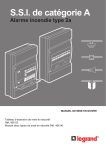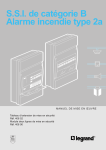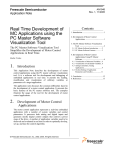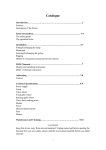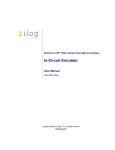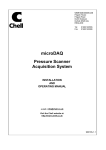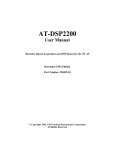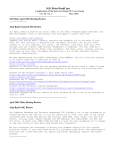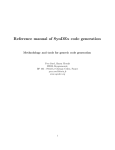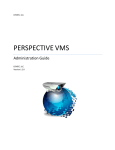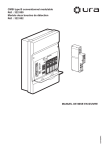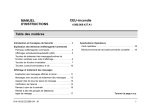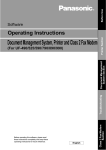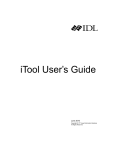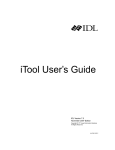Download Laboratory assignments:
Transcript
2010-01-29, Department of computer science and engineering EDA222 Real time systems Laboratory assignments: CONTROL AND MONITORING A MODEL RAILROAD Contents: 1 1.1 1.2 1.3 1.4 1.5 2 2.1 2.2 2.3 2.4 3 3.1 4 4.1 4.2 5 5.1 5.2 6 6.1 6.2 INTRODUCTION ................................................................................................. 2 Purpose Train simulator overview Train simulator commands Train simulator messages Train simulator configurations 2 2 3 4 5 COMMUNICATING WITH THE SIMULATOR ..................................................... 7 Control and status registers Sending commands to the simulator Receiving messages from the simulator. Control computer memory space 7 7 7 8 ASSIGNMENT 1 .................................................................................................. 9 Resource handler 9 ASSIGNMENT 2 ................................................................................................ 10 Testing commands to the simulator Monitoring messages from the simulator 11 11 THE FINAL ASSIGNMENT................................................................................ 11 Requirements on the program Practical hints 11 11 CRITERIAS TO PASS ....................................................................................... 12 Reporting and documentation Instructions for report writing 12 12 1 2010-01-29, Department of computer science and engineering 1 Introduction 1.1 Purpose The purpose with this laboratory assignment is to give a practical example of real time and machine oriented programming. Our example is a model railroad where two trains can be moving at the same time and independent of each other. The model railroad looks as follows: Figure 1: Final lab assignment simulator configuration Along the track there are exchanges and a number of sensors which gives information on the train positions. To avoid the practical problems with a real model railroad, we use a microcomputer (HCS12) to simulate the model railroad. This microcomputer system is called the train simulator. The picture of the model railroad is displayed in an X-window on the Linux work station. The communication between the simulator and the workstation is via a serial port. The model railroad is controlled from another microprocessor (MC68340) which we call the control computer. The control computer communicates with the train simulator using a serial link. This link is used to read sensor messages from the simulator and to send messages to the simulator to drive the trains and set the exchanges. A serial link between the control computer and the Linux workstaton is used to download the program to the control computer. 2 2006-10-09, Department of computer science and engineering The railroad consists of a short track, a number of trains, exchanges and sensors with the following properties: • • • Each train can drive forward or backward with different speeds. Each exchange can be set in two positions. The sensors that are located along the track signals when a train passes. Every sensor sends a message at both front end and back end of a train passage. • The train speed and the state of the exchanges can be controlled by messages sent to the train simulator serial port. It is also possible to deactivate the sensors so that they do not react at all. The assignment is to write the program for the control computer. The requirements are that two trains shall be able to share the railroad in a controlled way (that is without any accidants happening). The traditional solution to this type of problems is to use C or assembly language combind with interrupt handling. The synchronisation difficulties in these problems often lead to complicated solutions. We will se how elegant this problem can be solved using concurrent processes in Ada. 1.2 Train simulator overview The train simulator is implemented on a HCS12 microprocessor card. The control computer is a Motorola 68340 microcontroller card and is connected to the simulator using an RS232 serial link. In order to drive the trains and set the exchanges, commands are sent to the simulator on the serial link. Signals from the sensors are sent by the simulator in the other direction on the serial link. The control computer is also connected to a Linux workstation used for program development. The simulator is also connected to the Linux workstation and an X-window is used to present the simulated railroad. Work station Train simulator Terminal window 1 Control computer (MC68340 based) Simulator computer Terminal window 2 (MC68HCS12 based) Figure 2: Train simulator organisation The simulator and control microcomputers are mounted in a single box. The train simulator program is stored in FLASH memory. The simulator program starts automatically at power up, and can be restarted by pressing reset at the microcomputer box or by writing ‘q’ in the simulator window at Linux. The control computer contains a simple monitor db68 that makes it possible to communicate with the Linux workstation and to download programs to the microcomputer. 2 2006-10-09, Department of computer science and engineering 1.3 Train simulator commands This and the following section give a description of the commands that can be sent between the control computer and the simulator and the errors that can occur. Commands can be of four types: Configure This command restarts the train simulator. Trains, exchanges and sensors will “momentarily” be set to their initial positions (one of the few occasions there the model surpasses reality in performance). The command makes it possible to choose between a few different configurations. Set exchange Set an exchange in the specified position. Activate sensor The specified sensor is activated or deactivated. Set speed The speed for the specified train is set to specified value. The syntax of the configure command allows for 8 different configurations, each with a maximum of 16 exchanges, 16 sensors and 8 trains with a maximum of four speeds. Currently only four configurations are implemented. These configurations are described below. A command is always a group of eight bits transported over the serial link. This will be further explained below. Commands have a type field (the two least significant bits) used for a command type code. The other six bits have different meaning dependent of the type code. Command codes MSB 7 Bit number 6 5 4 LSB 3 Value field 0 Log 0 Off 0 Active Rev Rec. Speed 2 1 Command type 0 Type field C-number 0 0 Configure E-number 0 1 Set exchange S-number 1 0 Activate sensor 1 1 Set speed T-number The simulator interprets bits or bit fields in a command as follows: Log A flag that specifies that activities shall be logged in the simulator window Simplifies debugging of the program. Set this bit to ‘1’ if you want the simulator to print out the received commands, set this bit to ‘0’ if you want to suppress this action. Rec A flag that specifies that receipts shall be sent or not. Set this bit to ‘1’ if you want the simulator to acknowledge a command, set this bit to ‘0’ if you don’t want any acknowledges. C-number Specifies which track configuration you desire. The field should contain a binary number (0-7). NOTE: Some of these numbers are not valid since they not correspond to an implemented configuration (see below). Off Specifies if an exchange shall be set for turnoff or thoroughfare. Set 3 2006-10-09, Department of computer science and engineering this bit to ‘1’ if turnoff is desired, set this bit to ‘0’ if thoroughfare is desired. E-number Specifies which exchange to set. This should be a binary number ranging from 0 to 15. Active Specifies if a sensor shall be activated (set this bit to ‘1’) or deactivated (set this bit to ‘0’). S-number Specifies which sensor to activate (0-15). Rev Specifies if a train shall be driven forward (0) or backward (1). Speed the wanted speed for a train, 0 = stopped, 3 = maximum speed. T-number Specifies which train shall be controlled. 1.4 Train simulator messages The simulator sends notification messages to the control computer upon the following events: Receipt The latest command of the specified type has been completed or alternatively rejected for some reason Passage A sensor reacts when a train arrives to or leaves the place where the sensor is located. Catastrophe A train has collided, deranged or reversed. When a catastrophe is reported the simulator has to be reconfigured. The simulator recognizes the following “catastrophic” conditions: Collision A train may not be driven against another train or into a stop block. Deranging A train may not be driven into an exchange set in the wrong position nor can an exchange be repositioned while a train is passing. Reversing The direction of movement cannot be changed while a train is moving. To prevent a catastrophe the train first have to be stopped. Addressing A command has been given that references a component (train, exchange, sensor) that do not exist in the current configuration Messages returned from the simulator are encoded as follows: Coding of simulator messages MSB 7 Bit number 6 5 4 LSB 3 2 1 Value field 0 0 0 Start Rev Derang 0 0 Type field Error Type S-number Coll Message type T-number 4 0 0 Receipt 0 1 Sensor signal 1 0 Catastrophe 2006-10-09, Department of computer science and engineering Note that the type field is importanta for interpretation of the message. The general meanings of codes in the “value” field are explained as follows: Error Specifies that a command have been completed (0) or rejected (1) as the specified configuration, exchange, train or sensor cannot be addressed. Type Specifies the type for the message being acknowledged (see coding of commands). Start Specifies that a sensor has reacted at the beginning (1) or end (0) of a train. S-number specifies which sensor has reacted. Rev Specifies that direction of movement was reversed while the train was moving (1). Derang Specifies deranging (1). Coll Specifies collision (1). T-number Specifies which train has been hit by catastrophe. 1.5 Train simulator configurations While the C-number in a configuration command allows any value, 0-7, there are actually only four configurations that are valid (0-3). The following four configurations are thus accepted: Figure 3: Configuration ‘0’ The configuration shown in Figure 3 is intended for simple basic exercises such as to start and stop a train. The rails are represented with strait lines, and the end of a railroad track is marked with ’I’. A train is represented by a series of ‘o’ with the train number interjected. The train in the figure moves to the right, when given a command to move forward. Figure 4: Configuration ‘1’ Configuration ‘1’, shown in Figure 4, is intended for test of sensors. Sensors are marked by an arrow (’^’) with its number immediately to the right. There are 16 different sensors in the most advanced configuration. Numbers indicating sensors are in hexadecimal format, i.e. the first sensor is denoted ‘0’, the last sensor is denoted ‘F’. Note that a sensor pass results in a message sent from the simulator. I.e. you must have a working program capable to receive messages before you test this configuration. 5 2006-10-09, Department of computer science and engineering Figure 5: Configuration ‘2’ Configuration ‘2’, shown in Figure 5, can be used to test exchanges. All exchanges are shown in the turnoff position. The number of the exchange is shown above the movable part of the exchange. Figure 6: Configuration ‘3’ Configuration ‘3’, Figure 6 shall be useed in the final assignment. All exchanges are shown in turnoff position. The intention is to get the two trains moving simultaneously without colliding. 6 2006-10-09, Department of computer science and engineering 2 Communicating with the simulator A serial link is used for the communication with the simulator. The Motorola 68340 processor has two serial ports. Port A is used for communication with the Linux workstation and port B is used for communication with the train simulator. 2.1 Control and status registers The serial module in the 68340 processor have close to ten control registers that have to be programmed with the correct bit pattern to get the circuit working in the intended way. A proper initializition of those registers are programmed by calling the routine Init_port_B in the given package traintypes. You don’t have to be further bothered by this but you do have to recognize that the registers that have to be explicitly handled by your program is a status register and a data register for sending and reading characters on port B. These registers have the following addresses: Short name Description Address SRB Status register port B FFFFF719 TBB Data register for sending to port B FFFFF71B RBB Data register for receiving from port B FFFFF71B All these registers have 8 bits. All bits in the data register are used why both sent and received characters consist of 8 bits. The bits in the status register are described in the attached manual pages (se “Appendix: Excerpt from MC68340 USER’S MANUAL”). Observe that the bits are numbered according to the Little Endian method (from right to left) in the manual. The Gnu Ada 95 compiler on the other hand uses the Big Endian method (from left to right) in a record representation clause. A number of control registers are already defined in the package traintypes, but these are only used by the routine init_port_B. The registers mentioned above remains to be defined as part of your assignment. 2.2 Sending commands to the simulator Sending commands to the simulator is done by writing a character in the data register for port B (TBB). Beware that this is a direct communication with the underlying hardware. Before writing to the data register a check must be made that the circuit is prepared to receive a new character. This is done by reading the status register (SRB) and check that the correct bit is active. 2.3 Receiving messages from the simulator. The reception of characters from the train simulator is interrupt driven. Interrupt routines in Ada 95 is programmed using protected objects. To connect an interrupt handler with its interrupt vector, the routine attach_handler in the package Ada.interrupts is used. Alternatively the Pragma attach_handler can be used. The interrupt vector to be used is defined in the package Ada.interrupts.Names and is called PORTBINT. Finally the serial module in the processor must be ordered to use this interrupt vector. This is done by the 7 2006-10-09, Department of computer science and engineering routine init_port_B. The package traintypes includes a constant declaration for the interrupt vector, named ivector. It is a good idea to use this constant in the call of attach_handler. The ceiling priority of the protected object containing the interrupt handler should be set to 104 using pragma interrupt_priority. This corresponds to the hardware priority 4, which is set for the serial module by init_port_B. NOTE that it is cruisal to get a working module for both output (sending commands) and inputs (receiving commands) otherwise your assignments 2, 3 and final cannot be accomplished. 2.4 Control computer memory space 0 db68 data area 2000 SRAM 3000 512 K Ada program 7FFFF no memory 100000 Boot loader 11 0000 Flash memory db68 code area 512 K 120000 Flash libraries 170000 17FFFF Figure 6: Memory usage in the control computer 8 2006-10-09, Department of computer science and engineering 3 Assignment 1 3.1 Resource handler The first assignment is to write a resource handler for allocation of the single tracks. This assignment does not use the microcomputer system and is developed on a native Ada 95 compiler on either Linux or a Windows PC. However the resource handler shall be written so that it can be included in the final train program without changes. For this reason the program is structured as an Ada package and a simple main program for testing purposes. Skeleton files for the assignment are given in the directory: /chalmers/groups/cab_ce_edu_2010_eda222_rt_-/lib/lab1 at the Linux lab accounts. They are also available at the course homepage as: Assignment1.zip. The directory (this zip-file) contains the following files resource.ads resource.adb traintypes.ads restest.adb Start by creating a directory lab1 using the command: mkdir lab1. Copy the given files to this directory with the command: cp /chalmers/groups/cab_ce_edu_2010_eda222_rt_-/lib/lab1/* lab1 The file resource.ads is the complete package specification for the recourse handler. It is demanded that this specification remains unchanged. The file resource.adb is a skeleton body for the resource handler. The major part of the assignment is to complete this file. The file restest.adb is the main program used to test that the resource handler is working correctly. This program is only a skeleton that has to be completed. The file traintypes.ads only contains the type definition for a track. This file should not be changed. The program can be compiled with the command: gnatmake restest.adb and then executed by the command: ./restest The test program should test both correct and incorrect usage of the resource handler. It is however allowed to make temporary changes to test certain errors, for example that the same track cannot be allocated another time while it is still in use. In the final solution this resourse handler shall be used to control access to the three singletracks in figure 1. It is recommend that the tracks is given the numbers 0..6. This means that the single-tracks will get numbers 1, 3 and 5. This is the reason why the type track_part_type has interval 1..5 although there is only three resourses to control. There is no reporting needed for this assignment. Continue with assignment 2 when you have a working resource handler. 9 2006-10-09, Department of computer science and engineering 4 Assignment 2 In this assignment the Gnu Ada95 cross compiler is used to develop a control program for the train simulator that can be downloaded to and executed at the control microcomputer. Observe that this compiler is only available at the Linux machines in the Computer Engineering lab. Start by creating a new directory lab2 and copy the given files to this directory with the command : cp /chalmers/groups/cab_ce_edu_2010_eda222_rt_-/lib/lab2/* lab2 Directory lab2 should now contain the files traintypes.ads, command.ads, command.adb and main.adb. The file traintypes.ads contains type definitions for communication with the train simulator. The file command.ads specifies the interface to low level communication routines. This file is complete and may not be changed. The file command.adb contains the body for the low level communication routines and also the routine init_port_B. This file is incomplete and has to be completed. The file main.adb contains a skeleton main program that has to be completed. In the final solution the files resource.ads and resource.adb from lab1 should also be copied here. To use the gada68 cross compilers /cab/ce/sw/gada68/Linux/bin must be added to your path. Commands to set up your environment correctly for the compilers if you use bash shell can be found in the file: /chalmers/groups/cab_ce_edu_2010_eda222_rt_-/lib/bashrc The commands in this file shall be added to your own .bashrc file. If you use tcsh shell commands to add to your .tcshrc file can be found in: /chalmers/groups/cab_ce_edu_2010_eda222_rt_-/lib/tcshrc When .bashrc is modified you have start a new shell with bash or logout and log in again for the changes to have effect. The files in lab2 directory can now be separately compiled with the command: gada68 name.adb The object files can then be linked together with the command: gbind68 main Now you should have an executable program named main.x. Now start the terminal emulator 68term in a local X-window and download the file main.x to the 68340 microcomputer (se “Gnu Ada95 Cross Compiler for MC6xx0” for an instruction on how to do downloading). When the program is downloaded it can be started by giving the command: go 3000 When all files needed by the program are written it is best to do recompilations with the command gnatmake68 main. This program performs all needed recompilations and then executes the linker. To get shorter load time it is recommended to use the command gnatmake68f instead of gnatmake68. This command links against routines that are preinstalled in the flash memory on the 68340 microcomputer. The train simulator executes on a HCS12 microprocessor connected to the Linux workstation with a serial link. In order to start the train simulator, first open an extra X-window and give the command 68termb. This is the same program as 68term with the exception that it 10 2006-10-09, Department of computer science and engineering communicates on the serial port connected to the train simulator. If the train simulator does not start automatically, press the reset button at the microcomputer box. This will reset both the train simulator and the control microcomputer. The train simulator can also be restarted by writing ‘q’ (only the letter) when positioned in the simulator window. When the train simulator starts it gives the printout “READY FOR CONFIGURATION” in the X-window. 4.1 Testing commands to the simulator Start by writing a simple test program that configures the simulator as configuration 0 and starts the train. The train need not to be stopped, it is ok that it collides with the stop block. Next step is to control the exchanges. Use configuration 2 to verify that your program can set the exhanges in a desired position. 4.2 Monitoring messages from the simulator Rewrite the program so that the passage of a sensor can be detected. To do this the communication routines in package command.adb have to be completed. For this step (and the future steps) configuration 3 can be used. 5 The final assignment Configuration 3 shall be used in the final assignment. Program the body of task type train to allow the train to drive forward and backward at the track. Use the package resource from lab1 to allocate the single tracks. The exchanges connected to a single track should be set in correct position before the single track is entered. It is allowed to use the train number to select which double track to use. Other criteria such as the direction of the train may also be used. The direction of the train should change only when an endpoint is reached. The train should be able to drive at speed 3. The train task should be written in a general way so that it can be used for both trains with only a minimum of parameterization based on train number. Only activate one train in this step, but test with both train numbers. If the train task have been carefully written it should now be possible to get both trains running simultaneously just by activating both trains. If there are some problems you have to correct them. The trains shall start from the endpoints and move against each other. When a train reaches an endpoint it should turn back. The trains shall continue to run for ever without any accidents happening. Both trains shall be in movement at the same time. 5.1 Requirements on the program • The resource handler shall use Ada 95 protected objects. • Interrupt handling shall be used to receive messages from the simulator. • A general train task shall be implemented to drive the trains. • Both trains shall be able to run at speed 3. 5.2 Practical hints 11 2006-10-09, Department of computer science and engineering You should structure the problem by drawing an access graph. The access graph shall show the call structure between the different tasks and packages. An access grapf is required in your final documentation Wait for a receipt when a command has been sent to the simulator. This will guarantee that the simulator has read a command before a new command is sent. You will probably not be able to solve this assignment unless you do so. Tasks start in an arbitrary order. They have to be synchronized at start. Speed 0 forward is not the same as speed 0 backward. Trains have inertia. At the end stations the trains have to wait for 10 seconds after the speed is set to 0 before they can be started in the other direction. Recommendation: Do not call procedures in other protected objects from an interrupt handler. If despite of this recommendation this is done, the called protected object must be set to interrupt priority. It is not allowed to call an entry (or any potentially blocking operation) from a protected object when the real time annex is used. Use gnatmake68f. This gives much shorter download times than gnatmake68. 6 Criterias to pass A working program shall be demonstrated for an instructor during a lab session and the same program shall also be documented in a written report submitted to the instructor in due time (see course homepage). Only the final solution of source code needs to be submitted along with appropriate documentation. 6.1 Reporting and documentation At the demonstration each of the group members shall be able to explain all parts of the program. A preliminary version of the report should also be shown for the instructor at the demonstration. 6.2 Instructions for report writing The report shall include the following parts: • Program description • Access graph • Program listing The program description shall contain a short description of the problem and a detailed description of the packages, tasks and protected objects that implements the program. The report should be 3-4 pages and well structured. The program listings shall have file name and page number at every page (use a2ps). The report may be written in Swedish or English. The lab report should be submitted before the deadline specified at the course homepage. If the report is not approved it is returned and have to be resubmitted after corrections. The last date for approval is given at the course home page. 12 2006-10-09, Department of computer science and engineering 13 2006-10-09, Department of computer science and engineering APPENDIX A: Excerpt from MC68340 USER’S MANUAL NOTE: The entire chapter 7, detailing the UART device, from this handbook is available at the course homepage. 7.4.1.5 STATUS REGISTER (SR). The SR indicates the status of the characters in the FIFO and the status of the channel transmitter and receiver. This register can only be read when the serial module is enabled (i.e., the STP bit in the MCR is cleared). SRA, SRB $711, $719 7 6 5 4 3 2 1 0 RB FE PE OE TxEMP TxRDY FFULL RxRDY 0 0 0 0 0 0 0 RESET: 0 Read Only Supervisor/User RB-Received Break 1 = An all-zero character of the programmed length has been received without a stop bit. The RB bit is only valid when the RxRDY bit is set. Only a single FIFO position is occupied when a break is received. Further entries to the FIFO are inhibited until the channel RxDx returns to the high state for at least one-half bit time, which is equal to two successive edges of the internal or external 1x clock or 16 successive edges of the external 16x clock. The received break circuit detects breaks that originate in the middle of a received character. However, if a break begins in the middle of a character, it must persist until the end of the next detected character time. 0 = No break has been received. FE-Framing Error 1 = A stop bit was not detected when the corresponding data character in the FIFO was received. The stop-bit check is made in the middle of the first stop-bit position. The bit is valid only when the RxRDY bit is set. 0 = No framing error has occurred. PE-Parity Error 1 = When the with parity or force parity mode is programmed in the MR1, the corresponding character in the FIFO was received with incorrect parity. When the multidrop mode is programmed, this bit stores the received A/D bit. This bit is valid only when the RxRDY bit is set. 0 = No parity error has occurred. OE-Overrun Error 1 = One or more characters in the received data stream have been lost. This bit is set upon receipt of a new character when the FIFO is full and a character is already in the shift register waiting for an empty FIFO position. When this occurs, the character in the receiver shift 14 2006-10-09, Department of computer science and engineering register and its break detect, framing error status, and parity error, if any, are lost. This bit is cleared by the reset error status command in the CR. 0 = No overrun has occurred. TxEMP-Transmitter Empty 1 = The channel transmitter has underrun (both the transmitter holding register and transmitter shift registers are empty). This bit is set after transmission of the last stop bit of a character if there are no characters in the transmitter holding register awaiting transmission. 0 = The transmitter buffer is not empty. The transmitter holding register is loaded by the CPU32, or the transmitter is disabled. The transmitter is enabled/disabled by programming the TCx bits in the CR. TxRDY-Transmitter Ready This bit is duplicated in the ISR; bit 0 for channel A and bit 4 for channel B. 1 = The transmitter holding register is empty and ready to be loaded with a character. This bit is set when the character is transferred to the transmitter shift register. This bit is also set when the transmitter is first enabled. Characters loaded into the transmitter holding register while the transmitter is disabled are not transmitted and are lost. 0 = The transmitter holding register was loaded by the CPU32, or the transmitter is disabled. FFULL-FIFO Full 1 = A character was transferred from the receiver shift register to the receiver FIFO and the transfer caused the FIFO to become full (all three FIFO holding register positions are occupied). 0 = The CPU32 has read the receiver buffer and one or more FIFO positions are available. Note that if there is a character in the receiver shift register because the FIFO is full, this character will be moved into the FIFO when a position is available, and the FIFO will remain full. RxRD-Receiver Ready 1 = A character has been received and is waiting in the FIFO to be read by the CPU32. This bit is set when a character is transferred from the receiver shift register to the FIFO. 0 = The CPU32 has read the receiver buffer, and no characters remain in the FIFO after this read. 15 2006-10-09, Department of computer science and engineering APPENDIX B: The following source code is available from the course home page. This appendix is for your reference. -- traintypes.ads -- Type declarations for the Ada95 train lab assignment -- 06-09-27 Arne Dahlberg with calendar, system, system.storage_elements; with Ada.Interrupts.Names; use calendar, system, system.storage_elements; package traintypes is -- Miscellaneous types -- 8-bit type for genaral use subtype byte is integer range 0..255; -- Type for accessing hardware registers type bits is range 0..255; for bits’size use 8; -- Type declarations for commands to the simulator type command_type is (CONF, SWITCH, SENS, SPEED); for command_type use (CONF => 0, SWITCH => 1, SENS => 2, SPEED => 3); subtype subtype subtype subtype subtype conf_nr_type is integer range 0..7; train_nr_type is integer range 0..7; switch_nr_type is integer range 0..15; sens_nr_type is integer range 0..15; speed_type is integer range 0..3; type yesno_type is (NO, YES); for yesno_type use (NO => 0, YES => 1); type direct_type is (STRAIT, OFF); for direct_type use (STRAIT => 0, OFF=> 1); type drive_dir_type is (FORW, BACKW); for drive_dir_type use (FORW => 0, BACKW => 1); type conf_cmd_type is record ctype : command_type; conf_nr : conf_nr_type; ack : yesno_type; log : yesno_type; unused : yesno_type := NO; end record; for conf_cmd_type use record ctype at 0 range 6..7; conf_nr at 0 range 3..5; ack at 0 range 2..2; log at 0 range 1..1; unused at 0 range 0..0; end record; for conf_cmd_type’size use 8; type switch_cmd_type is record ctype : command_type; switch_nr : switch_nr_type; direct : direct_type; unused : yesno_type := NO; end record; 16 2006-10-09, Department of computer science and engineering for switch_cmd_type use record ctype at 0 range 6..7; switch_nr at 0 range 2..5; direct at 0 range 1..1; unused at 0 range 0..0; end record; for switch_cmd_type’size use 8; type sens_cmd_type is record ctype : command_type; sens_nr : sens_nr_type; active : yesno_type; unused : yesno_type := NO; end record; for sens_cmd_type use record ctype at 0 range 6..7; sens_nr at 0 range 2..5; active at 0 range 1..1; unused at 0 range 0..0; end record; for sens_cmd_type’size use 8; type speed_cmd_type is record ctype : command_type; train_nr : train_nr_type; speed : speed_type; drive_dir: drive_dir_type; end record; for speed_cmd_type use record ctype at 0 range 6..7; train_nr at 0 range 3..5; speed at 0 range 1..2; drive_dir at 0 range 0..0; end record; for speed_cmd_type’size use 8; -- Control word declarations for serial port B ILR_address : constant System.address := to_address(16#FFFFF704#); IVR_address : constant System.address := to_address(16#FFFFF705#); ISR_address : constant System.address := to_address(16#FFFFF715#); IER_address : constant System.address := to_address(16#FFFFF715#); MR1B_address : constant System.address := to_address(16#FFFFF718#); MR2B_address : constant System.address := to_address(16#FFFFF721#); CSRB_address : constant System.address := to_address(16#FFFFF719#); CRB_address : constant System.address := to_address(16#FFFFF71A#); D_ILR : bits; for D_ILR’address use ILR_address; D_IVR : bits; for D_IVR’address use IVR_address; D_ISR : bits; for D_ISR’address use ISR_address; D_IER : bits; for D_IER’address use IER_address; D_MR1B : bits; for D_MR1B’address use MR1B_address; D_MR2B : bits; for D_MR2B’address use MR2B_address; D_CSRB : bits; for D_CSRB’address use CSRB_address; D_CRB : bits; for D_CRB’address use CRB_address; 17 2006-10-09, Department of computer science and engineering -- Init definitions for Port B ivector : constant := Ada.Interrupts.Names.PORTBINT; cmd_reset_receiver : bits := bits(16#20#); cmd_reset_transmitter : bits := bits(16#30#); cmd_reset_errorstatus : bits := bits(16#40#); cmd_reset_break : bits := bits(16#50#); rec_irq_enable: bits := bits(16#24#); -- rec int. B + brk int. A enable cmd_enable_receiver : bits := bits(16#01#); cmd_enable_transmitter : bits := bits(16#04#); MR1B_init : constant bits := bits(16#13#); -- 8 bits, no parity MR2B_init : constant bits := bits(16#07#); -- normal, 1 stop bit CSRB_init : constant bits := bits(16#BB#); -- 9600 baude, Rx and Tx ILEVEL : bits := bits(16#04#); -- Interrupt level port A and portB !! VECTOR : bits := bits(ivector); -- Interrupt vector port A and port B !! -- Type declarations for messages from simulator --Write your own declarations for this part end traintypes; 18



















